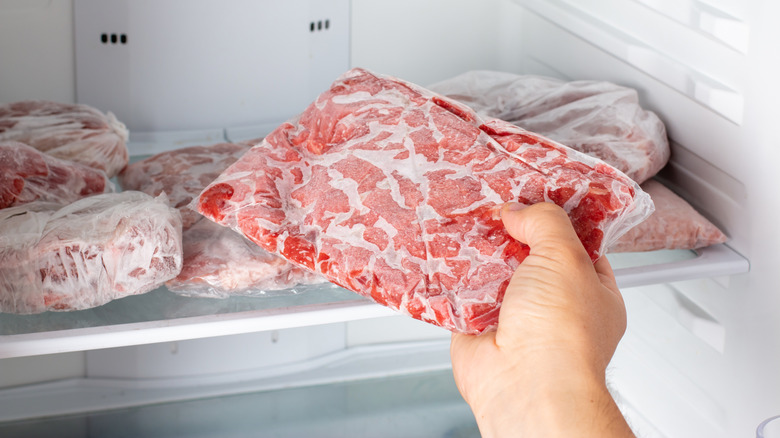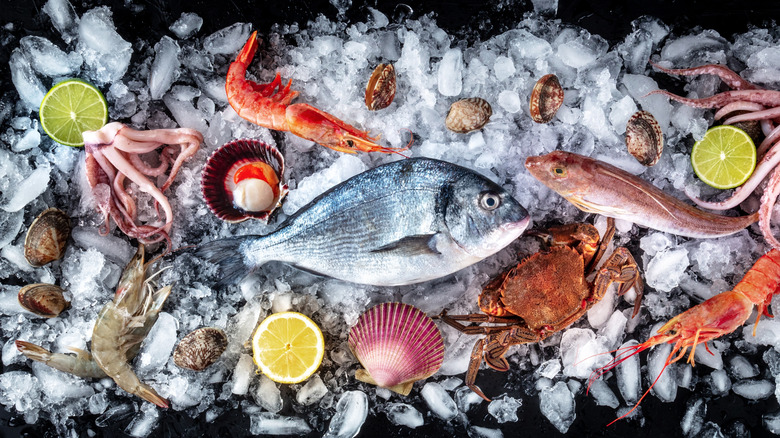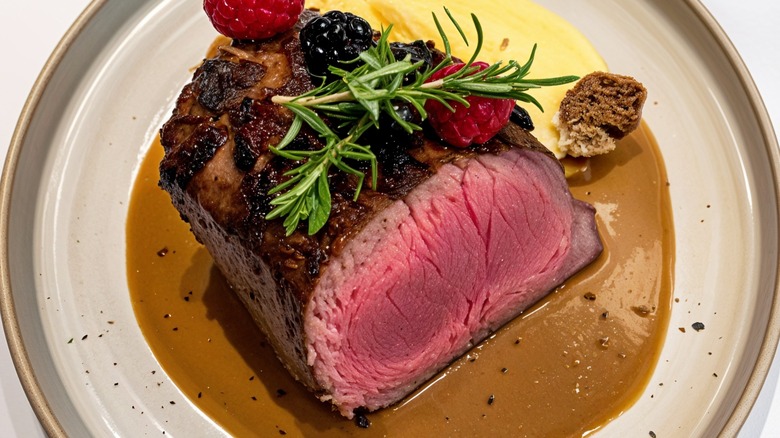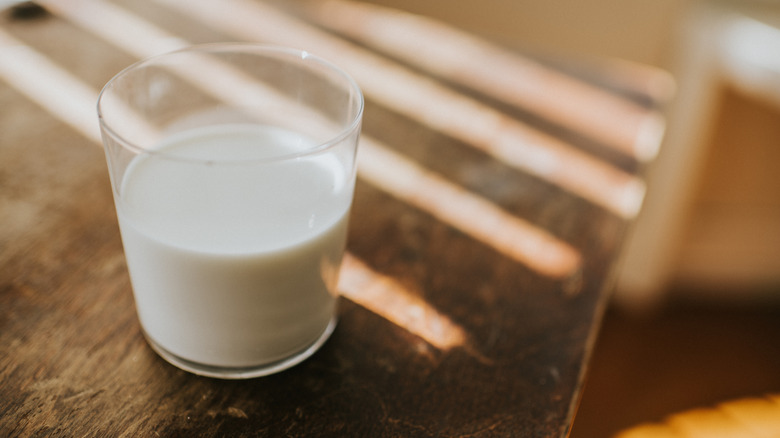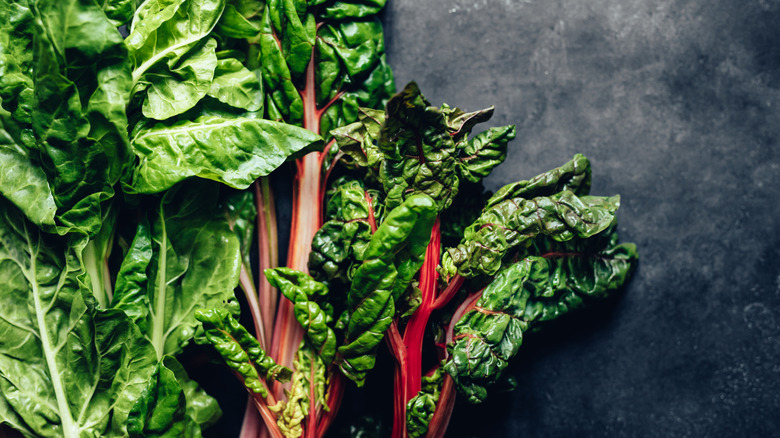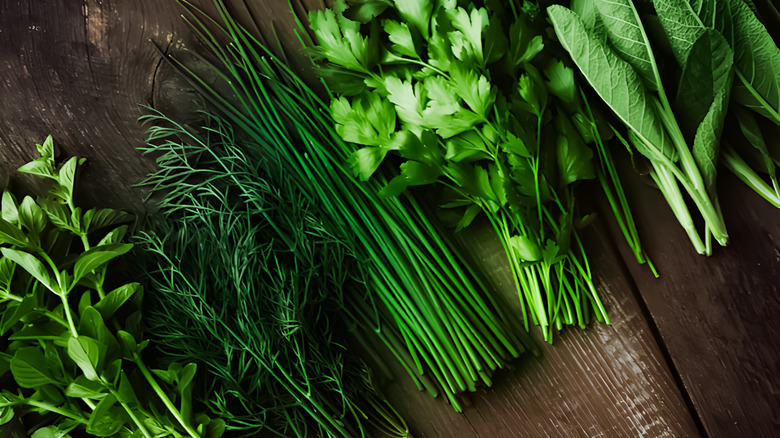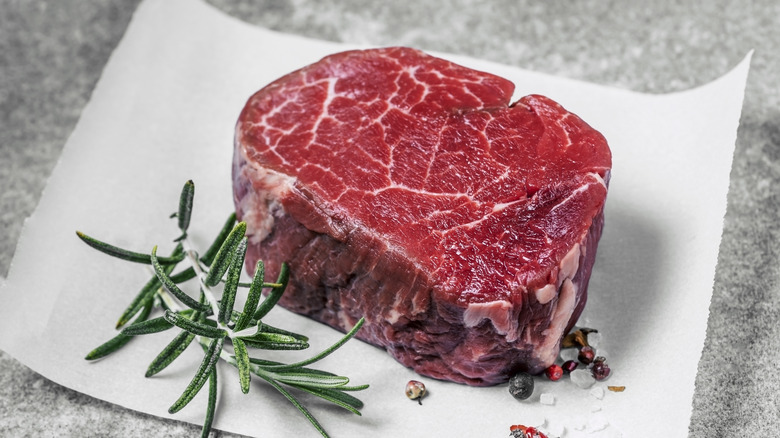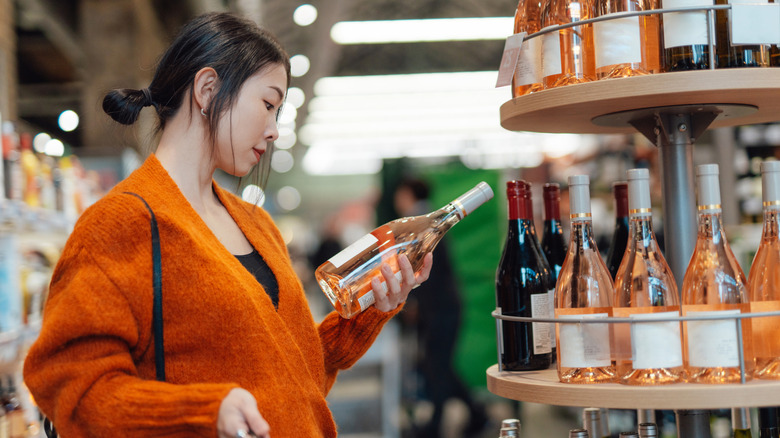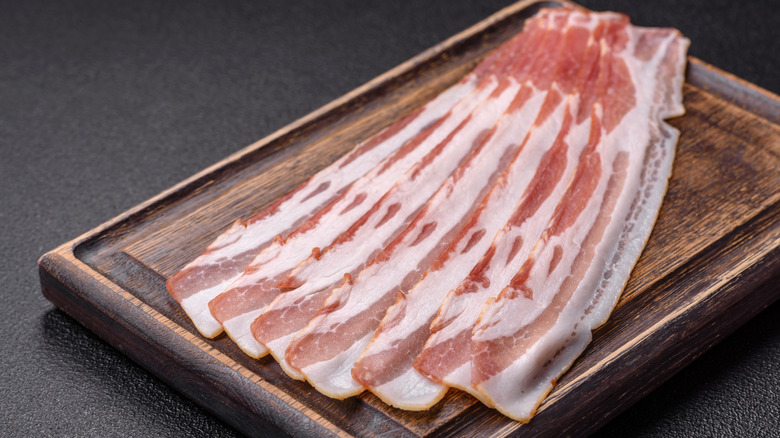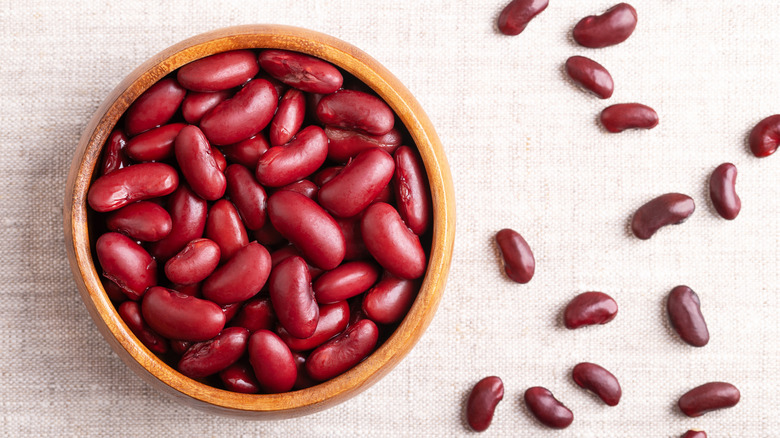12 Foods That Don't Belong In A Slow Cooker
Slow cookers have become very popular since making their commercial debut in the 1950s, with approximately 80% of today's households using the appliance as a part of their cooking routine (via Betty Crocker). And it's easy to see why. Compact and lightweight, slow cookers – or Crock-Pots — are perfect for any foods that require low and slow cooking, like chilis, stews, soups, and tough cuts of meat. They are also very easy to use — all you need to do is throw in the ingredients, turn the gadget on, and forget it until you are ready to eat. In addition, slow cookers are more energy efficient than traditional ovens, which is great news for the budget-conscious.
Despite their many benefits, however, slow cookers are not designed to handle all types of food. This is largely due to the appliance's moist, low-temperature cooking over long periods — a process that can ruin more delicate foods and make others downright unsafe to eat. Ready to discover what kitchen staples don't fare well in a Crock-Pot? Keep reading to find out what ingredients could ruin your next slow cooker masterpiece.
Frozen meat and poultry
Placing frozen meat and poultry directly in a slow cooker isn't just going to affect the texture and flavor, it's also likely to make them unsafe to eat. After all, there is a good reason why we keep perishables in the refrigerator. Whether it's an entire turkey, a chicken thigh, or a cut of beef, if left long enough in the "danger zone" between 40 and 140 degrees Fahrenheit, proteins can start to develop harmful bacteria.
Given that slow cookers heat gradually, the interior of the frozen meat and poultry — particularly larger pieces — can remain in the temperature "danger zone" long enough to spoil. Meat and poultry need to reach 140 degrees Fahrenheit within two hours of being taken out of the freezer to remain safe to eat — Crock-Pots simply take too long for this to happen. On top of that, placing frozen food in a slow cooker is likely to lower the gadget's overall temperature, only adding to the problem. Opening the lid to break apart frozen pieces of meat and poultry also prolongs the cooking time, allowing any dangerous pathogens in the food to multiply.
To keep food safe, it's important to thaw meat and poultry the right way — and this definitely doesn't involve a slow cooker. While it can take a little planning, the best way to defrost meat is in the refrigerator overnight. If time is of the essence, meat and poultry can also be thawed in cold tap water or the microwave. The caveat is that any meat and poultry thawed in the microwave needs to be cooked immediately.
Most fish and seafood
Slow cookers are designed to prepare food using low temperatures over many hours, which can be great for collagen-rich meats, but disastrous for seafood. From delicate fish to shrimp, clams, and mussels, most seafood cooked in a Crock-Pot will come out overcooked, rubbery, and generally unappetizing. After all, there is a good reason why most seafood recipes call for short cook times.
There are exceptions to most culinary guidelines, and preparing some seafood in a slow cooker can work, provided that you are strategic about the choice of protein and timing. One dish that lends itself to slow cooking is seafood stew, as long as the broth is placed in the gadget and allowed to simmer before the seafood is thrown into the mix in the last 20 to 30 minutes of preparation. Still, delicate shellfish such as clams and mussels are not recommended for this technique. Instead, opt for firmer options like squid and octopus, which can withstand longer cooking times.
Firmer fish that hold their shape, such as salmon, can be prepared in a Crock-Pot, as long as the fillets are relatively thick — they may fall apart and overcook otherwise. If you are cooking for large groups, stack the fillets on top of one another in the slow cooker basket, layering parchment paper in between to prevent sticking.
Lean cuts of meat
While Crock-Pots are ideal for tenderizing tough cuts of meat such as brisket, chuck roast, oxtail, and pork shoulder, they are not the best option for preparing lean protein with minimal fat and connective tissue. Collagen-rich cuts can withstand — and actually need — long cooking times as the collagen takes time to break down into gelatin, adding to the richness of the final dish. On the other hand, using a slow cooker to cook lean meat like tenderloin, chicken breast, and pork chops is likely to result in a dry and unappealing dinner.
Lean cuts of meat like pork chops are best when seared to lock in moisture and preserve tenderness. Whether preparing a nice cut of steak or lamb chops, there are few better methods to highlight their best attributes than grilling or pan-frying. Unlike slow cooking, these traditional food preparation methods create a flavorful crust while keeping the interior of the meat tender and juicy.
Poultry with the skin on
One of the best things about well-prepared chicken wings or drumsticks is their crispy exterior. The crackly, golden skin makes the poultry delicious with just a sprinkle of salt, spices, or a simple glaze. Unfortunately, this crispy outer is impossible to replicate in a slow cooker. This is because Crock-Pots rely on moist heat to cook food slowly and evenly, which will steam the chicken skin instead of making it deliciously crispy. Even browning the chicken on a skillet before transferring it to a slow cooker won't preserve the crispiness, gradually turning the skin soggy.
Preparing chicken with the skin on in a slow cooker is likely to leave it soft and rubbery. This in turn may leave the chicken meat greasy and unappetizing — a far cry from the golden, crackling texture of roasted or pan-fried poultry. While you can always remove the soggy skin from the poultry after cooking, this may compromise its flavor profile, especially if a seasoning or marinade was applied directly to the chicken's surface. Perhaps one Redditor sums this up best, saying, "If you remove the skin, then the meat has a chance to absorb all the flavorings of whatever cooking liquid you're using. Leaving the skin on tends to insulate it from that."
Milk and cream
Dairy can add moisture to desserts, imbue soups and sauces with a rich texture, and balance flavors in spicy curries. However, recipes that include dairy are a big no-no when it comes to Crock-Pots for the simple reason that they tend to separate and curdle when subjected to heat — especially for prolonged periods of time. This also goes for plant-based milks, such as coconut milk.
The fact that dairy and slow cookers don't mix doesn't mean that using them to make creamy chowders and soups is completely off limits. Cream and milk can be easily mixed into a dish toward the end of the cooking process, or even after it has already been prepared. Alternatively, dairy can also be used as a topping once the meal is already plated. Notably, evaporated milk doesn't curdle in the slow cooker, since around 60% of its moisture has been removed. This means that canned milk is perfect for slow cooker soups, giving them a rich and creamy texture.
When it comes to dairy and slow cookers, cheese is a bit of an anomaly. This is because it doesn't separate as easily as cream and milk when heated. The trick is to add cheese to the slow cooker an hour before removing the dish from the appliance to allow it to melt without clumping. For best results, use a full-fat cheese like cheddar or Colby.
Delicate vegetables
Many recipes that can be prepared in a slow cooker call for vegetables. However, while firmer veggies tend to hold up well even when cooked for long periods, this doesn't apply to other, more delicate varieties. For instance, a stint in a Crock-Pot can do wonders for root vegetables like carrots and parsnips. On the other hand, veggies like asparagus, spinach, zucchini, and pumpkin are better suited to faster cooking methods due to their fragile texture.
Since different vegetables have different cooking times, be mindful of when you toss them in the pot, adding the sturdier veggies way ahead of the more delicate ones. Firm vegetables, such as beets, potatoes, and carrots, can cook for hours. Cauliflower, cabbage, and bell peppers shouldn't be left in the slow cooker for longer than two to three hours. Meanwhile, broccoli florets, asparagus, and okra are likely to start turning mushy after 15 to 30 minutes of slow cooking. The most delicate vegetables like spinach and other greens, bok choy, and peas should only be added to the Crock-Pot at the very last minute.
Another trick that can prevent vegetables from going mushy in a slow cooker is layering. For example, when making a stew, place the beef at the bottom of the appliance, where the protein will be close to the heat source. Any dense veggies should be placed on top of the meat and covered with broth. Add any delicate veggies on top of this at a later stage of the cooking process to prevent them from overcooking.
Fresh herbs
Typically more fragile than most delicate vegetables, fresh herbs tend to wilt in a slow cooker. They also lose a lot of their flavor, which is exactly why they're added to recipes in the first place. This, however, doesn't mean that you can't use the subtle notes of fresh herbs like coriander, basil, and parsley to flavor your slow-cooked dishes — just add them at the end of the cooking time rather than when you first fire up the appliance. Alternatively, fresh herbs make wonderful garnishes, giving dishes a bright and fresh finish. That said, some firmer herbs, such as thyme, sage, and rosemary, are a notable exception to this rule and can be added to the slow cooker earlier during the cooking process.
Unlike many fresh herbs, dry herbs are well-suited to slow cooking. They are sturdier and release their flavor over time, which means that they perform well in Crock-Pots. For optimal results, add half the amount of dried herbs and spices specified in the recipe at the beginning of the slow cooking process, and adjust the flavor later as required. In addition, go easy on dried chili and garlic powder, as slow cooking can concentrate their flavors, making the dish unbalanced or even overpowering.
Prime cuts of steak
Prized for their tenderness, marbling, and flavor, cuts of beef like tenderloin, ribeye, and New York strip can be found on the menus of most high-end chain steakhouses. And there is a great reason why none of these establishments prepare them in a slow cooker. Prime cuts of steak shine when cooked quickly over high heat. Ultimately, this is what makes them crusty and flavorful on the outside and wonderfully juicy and tender on the inside.
While Crock-Pots are ideal for tenderizing tough cuts of beef over time, using one to cook a pricey cut of beef would be nothing short of wasteful. While edible, slow-cooked prime steak would lose its signature texture and flavor, resulting in a bland and unremarkable meal. As one Quora user puts it, "They are not well-designed for slow braising. It is an oversimplification that slow cooking makes meat tender; it does for meats that have a fair amount of connective tissue, but ones that don't — it just makes [it] tough."
Wine and other liquor
From quick vodka cream pasta to pot roasts, alcohol is often added to recipes to intensify flavors and enhance the overall depth. When prepared on the stove or in the oven, some of the liquor evaporates during the cooking process, ensuring that the final dish won't get your family drunk at the dinner table. However, this story is very different when boozy recipes are prepared in a slow cooker. While the final dish may not get anybody intoxicated, it is likely to turn out surprisingly intense in flavor.
Slow cookers are sealed during the entire cooking process, which means that the alcohol won't be able to evaporate and reduce, giving the food an overly boozy flavor. One Redditor describes the problem, saying, "The issue is that the lid will be on for most of the cooking, so a lot of the alcohol will condense on the lid and drip back in." In addition, slow cookers typically don't reach temperatures high enough to fully boil off alcohol. Luckily, there is a way of getting around this. To reduce the amount of alcohol, simmer it with other ingredients in a skillet before transferring the concoction to a Crock-Pot.
Bacon
A long-standing breakfast favorite, bacon is commonly used to add a smoky flavor and crunchy texture to eggs and pancakes. Bacon bits also make a flavorful garnish for spaghetti carbonara, Caesar salads, and loaded restaurant-worthy baked potatoes. Unfortunately, bacon doesn't do well in a slow cooker, which steams it rather than making it crispy. The result? Limp and soggy rashers. This problem isn't unique to bacon — Crock-Pots are far from ideal for preparing anything with a crispy texture, including French fries and fried chicken.
The best way to incorporate bacon in slow-cooked dishes isn't by adding it directly to the dish straight out of the packet. Instead, fry the bacon in a pan or bake it in the oven until crispy and then crumble it as a garnish once the dish is served. To cut a long story short, bacon will be edible no matter how it's prepared in a slow cooker — it just might not be good, as highlighted by one Reddit user: "I wrapped a pork tenderloin in raw bacon (sliced thick from an uncut piece). It cooked but I didn't really dig the texture. It was soggy like other slow cooked meats, which kept in the flavor but had a weird mouthfeel."
Dried beans
At first glance, dried beans make a perfect candidate for a slow cooker. After all, they normally need to be soaked overnight and cooked low and slow until tender — precisely what Crock-Pots are made for. However, it pays to think twice before tossing a batch of beans in a slow cooker, since if not prepared correctly, some of the legumes — especially red kidney beans — could actually make you sick.
Some dried beans contain a toxin called phytohaemagglutinin, which is only eliminated once they are boiled for a certain period of time. Given that slow cookers don't reach very high temperatures, they may only partially boil the legumes, leaving behind enough of the toxin to cause abdominal pain, nausea, and vomiting. Some more severe cases of this food poisoning can even lead to hospitalization. To eliminate the toxin, soak the beans in water for a minimum of five hours before draining them. Place the beans in a new pot of water and boil them at 212 degrees Fahrenheit for at least 10 minutes, and ideally half an hour.
Leftovers
Reheating the leftovers from last night's dinner in a slow cooker may seem appealing — it's hands-free, and the gadget could seemingly keep the food warm for hours. However, in reality, warming food in a Crock-Pot instead of the stovetop, oven, or microwave can lead to food safety issues.
Any leftovers should be refrigerated within two hours of cooking. They should then be reheated until they reach the internal temperature of 165 degrees Fahrenheit relatively quickly. To cut a long story short, the food shouldn't be left out in the so-called "danger zone" between 40 and 140 degrees Fahrenheit for more than two hours. Given that slow cookers heat up slowly, they may not heat the food to 165 degrees Fahrenheit fast enough to stop harmful bacteria from multiplying. Once brought up to a safe temperature on the stove, the leftovers can be stored in a slow cooker, provided that the appliance has been preheated to at least 140 degrees Fahrenheit.

